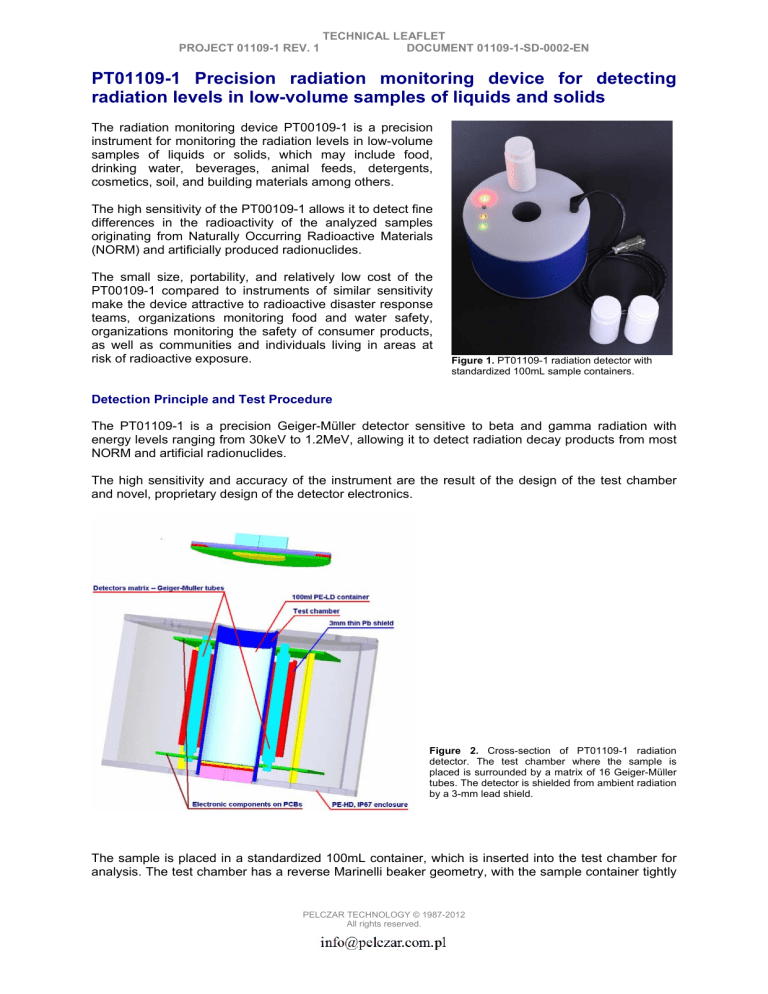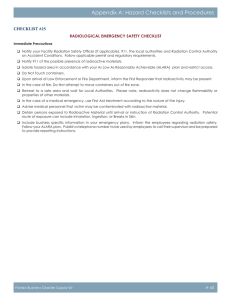
PROJECT 01109-1 REV. 1 TECHNICAL LEAFLET DOCUMENT 01109-1-SD-0002-EN PT01109-1 Precision radiation monitoring device for detecting radiation levels in low-volume samples of liquids and solids The radiation monitoring device PT00109-1 is a precision instrument for monitoring the radiation levels in low-volume samples of liquids or solids, which may include food, drinking water, beverages, animal feeds, detergents, cosmetics, soil, and building materials among others. The high sensitivity of the PT00109-1 allows it to detect fine differences in the radioactivity of the analyzed samples originating from Naturally Occurring Radioactive Materials (NORM) and artificially produced radionuclides. The small size, portability, and relatively low cost of the PT00109-1 compared to instruments of similar sensitivity make the device attractive to radioactive disaster response teams, organizations monitoring food and water safety, organizations monitoring the safety of consumer products, as well as communities and individuals living in areas at risk of radioactive exposure. Figure 1. PT01109-1 radiation detector with standardized 100mL sample containers. Detection Principle and Test Procedure The PT01109-1 is a precision Geiger-Müller detector sensitive to beta and gamma radiation with energy levels ranging from 30keV to 1.2MeV, allowing it to detect radiation decay products from most NORM and artificial radionuclides. The high sensitivity and accuracy of the instrument are the result of the design of the test chamber and novel, proprietary design of the detector electronics. Figure 2. Cross-section of PT01109-1 radiation detector. The test chamber where the sample is placed is surrounded by a matrix of 16 Geiger-Müller tubes. The detector is shielded from ambient radiation by a 3-mm lead shield. The sample is placed in a standardized 100mL container, which is inserted into the test chamber for analysis. The test chamber has a reverse Marinelli beaker geometry, with the sample container tightly PELCZAR TECHNOLOGY © 1987-2012 All rights reserved. PROJECT 01109-1 REV. 1 TECHNICAL LEAFLET DOCUMENT 01109-1-SD-0002-EN surrounded by a Geiger detector matrix comprising 16 Geiger-Müller tubes. Each Geiger-Muller tube has a separate readout interface and particle counter. The use of the standardized sample container ensures that the sample always has the same position in the test chamber and simplifies the sample collection, storage, and analysis procedures. Figure 3. PT01109-1 radiation detector GM matrix. The device is shipped with a removable beta particle filter, which makes the device sensitive to gamma rays only. The gamma efficiency of the indicator matrix (from the specimen’s perspective) is approximately 8%. The efficiency of the direct photon absorption depends on the photon energy: 29 cps/mR/h for 190keV (Ra226), 25 cps/mR/h for 660keV (Cs137), and 22 cps/mR/h for 1.2MeV (Co60). The test chamber and the detectors matrix are shielded from environmental interference by a Pb layer. The result of the radioactive emission test is delivered in counts of captured gamma photons and beta particles per second and per 100ml of sample volume [cps/100ml]. The calibration of the device is performed by calibration using a reference sample with a known radioactivity level. The polyethylene housing of the PT01109-1 enclosure has been designed to be IK06- and IP67compliant and can be immersed in running water and washed. PELCZAR TECHNOLOGY © 1987-2012 All rights reserved. PROJECT 01109-1 REV. 1 TECHNICAL LEAFLET DOCUMENT 01109-1-SD-0002-EN Data analysis The PT01109-1 is equipped with a RS232 interface, which is used for connecting the device to a PC for data capture and analysis. In the basic configuration, the PT00109-1 can be controlled through a terminal program running on the PC and can send raw measurement data from all 16 measurement channels to the PC for analysis. The data from PT01109-1 can be received by using any terminal software e.g. Hyper Terminal or TeraTerm. The simplest, but very powerful way to view the measurement result is to copy the messages received from the terminal software to OpenOffice Calc worksheet template. Custom software with built-in data analysis functions tailored to the customer’s needs can be provided upon request. Figure 5. Raw data received from PT00190-1 using standard terminal software Conformity The PT01109-1 has been designed to meet the requirements of the following standards: o ANSI N42.35-2004 Evaluation and Performance Criteria of Radiation Detection Portal Monitor for Use in Homeland Security (excluding requirements 5.10 and 5.10.4. o EN 61000-6-2 Immunity standard for industrial environments o EN 61000-6-4 Emission standard for industrial environments PELCZAR TECHNOLOGY © 1987-2012 All rights reserved. PROJECT 01109-1 REV. 1 TECHNICAL LEAFLET DOCUMENT 01109-1-SD-0002-EN Detection of low-level NORM and TENORM radiation in food and beverages Abstract Most substances occurring in nature contain naturally occurring radioactive materials (NORM) and spurs of artificial radionuclides. Whereas low levels of radiation from natural and artificial radionuclides nuclear sources are not considered harmful to humans, natural or industrial food and beverage production processes can lead to a concentration of radionuclides. Natural radionuclide concentration is performed by plants, which extract minerals from the soil, concentrating them in their tissues. Industrial processes of food production such as evaporation can further concentrate the radionuclides to levels that can be potentially harmful to humans when ingested. In this application note, we show how the PT01109-1 precision radiation monitoring device can be used to detect the radiation level in food and beverages, and present a study, where the radiation levels in commercially-available medicinal herbs are compared. Experimental Procedure For the characterization and calibration of the PT01109-1 precision radiation device, we used two reference samples, T0 and T1, both enclosed in standard 100ml sample containers. Reference sample T0 contains 100ml of table salt (NaCl), which has very low radioactive emissions and stable physical properties. Reference sample T1 contains a metal rod with a length of 12mm and a diameter of 2mm, sealed in white paraffin in the standard 100ml sample container. The metal rod used in T1 reference sample is a part of thoriated tungsten welding electrodes, and contains approx. 2% thorium Th232. The reference sample T1 therefore serves as a weak radiation source. (Note: Tungsten-thorium welding electrodes are available for purchase in hardware stores without restrictions. The reference sample T0 and T1 can be shipped with the device upon request). Using the PT01109-1, we compared the radiation levels of the reference samples T0 and T1 to the radiation levels of six different medicinal herbs purchased from a local supermarket. These herbs included lavender (Lavandula), Horsetail (Equisetum L.), melissa, pot marigold (Calendula officinalis L.), liquorice (Glycyrrhiza), and camomile. Each herb sample comprised 100ml of dried herbs placed in the standard sample container for analysis. Each of the tested samples were placed into the test chamber for analysis. The integration time was set to N = 800 sampling periods, where each sampling period has a duration of 8 seconds. The long integration time was set to allow the detection of very small differences in the radioactivity of the tested samples. All tested herb samples have significantly higher radiation than the low-radiation reference sample T0 (table salt). Of all herb samples, liquorice (sample D5) was found to be least radioactive (x D5 =7.435, σx = 0.056). The radioactivity of pot marigold (x D6 =7.572, σx = 0.056) was found to be significantly higher than that of liquorice (t = 1.732, df = 1598, p = 0.0418). Liquorice was the only herb to be significantly less radioactive than the thoriated welding electrode weak radiation source T0 (t = 2.938, df = 1598, p = 0.0017). Horsetail and lavender were found to be most radioactive. The radioactivity of horsetail (x D2 =7.435, σx = 0.056) and was found to be significantly higher than that of the weak radiation source T0 (t = 3.050, df = 1598, p-value = 0.0012). Also lavender (x D2 =7.435, σx = 0.056) was found to be significantly more radioactive than the radiation source T0 (t = 2.1839, df = 1598, p-value = 0.01456). The experimental results show that the PT01109-1 can be used for detecting very fine differences in radiation levels of different substances. In this experiment, the integration time was set very long (6400s) to minimize the error. For this integration time, the standard error of the mean was approx 0.06. For a 5-minute test (N = 40 integration steps), the standard error of the mean is 0.254 and has a standard deviation of σ = 0.024. PELCZAR TECHNOLOGY © 1987-2012 All rights reserved. PROJECT 01109-1 REV. 1 Sample Number T0 Sample Name Mean detected radioactivity [cps/100ml] Standard deviation Number of repetitions Standard error of the mean T1 TECHNICAL LEAFLET DOCUMENT 01109-1-SD-0002-EN D1 D2 D3 D4 D5 D6 Liquorice (Glycyrrhiza) Camomile Table Salt Weak radiation source (Th232) Lavender (Lavandula) Horsetail (Equisetum L) Melissa Pot Marigold (Calendula officinalis L.) 7.109 7.670 7.672 7.926 7.850 7.572 7.435 7.684 1.572 1.623 1.628 1.728 1.668 1.583 1.574 1.648 800 800 800 800 800 800 800 800 0.056 0.057 0.058 0.061 0.059 0.056 0.056 0.058 Table 1. Radioactivity of medicinal herbs measured with the PT01109-1 with an integration time of 800 sampling periods. Figure 5. Measured radioactivity (beta and gamma count) and standard errors in cps/100ml for reference samples T0 and T1 and medicinal herb samples D1 to D6. PELCZAR TECHNOLOGY © 1987-2012 All rights reserved.



